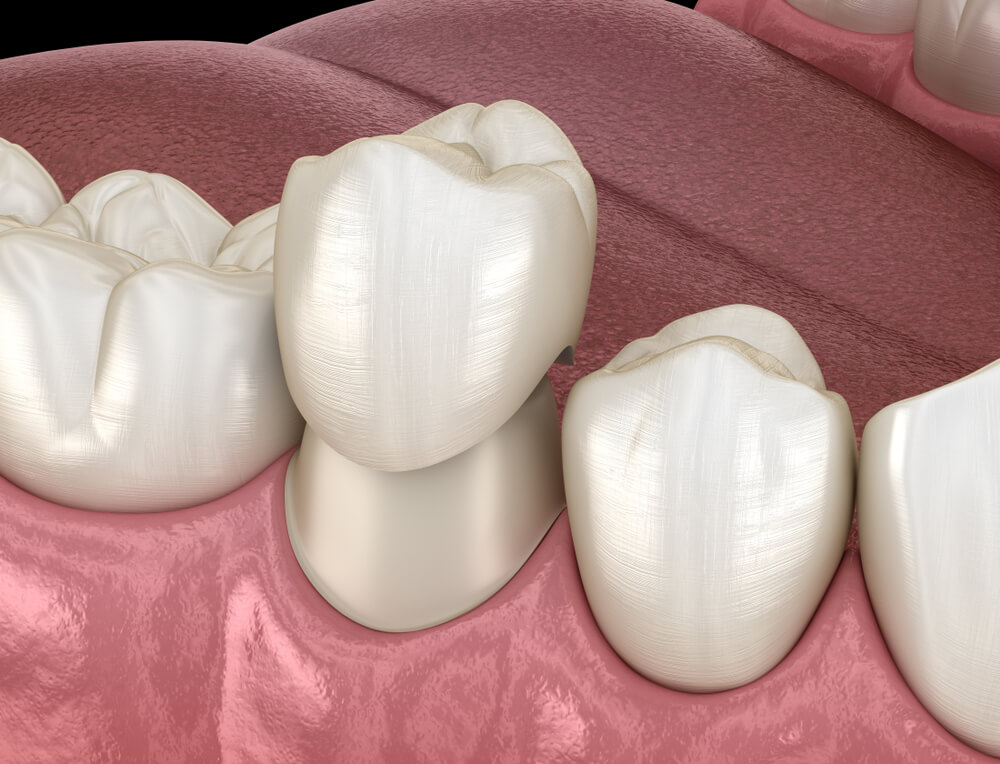Restorative dentistry has a variety of options for repairing damaged, decayed, or missing teeth. One of the more popular methods are dental crowns and bridges. Dental crowns are used to restore decayed or damaged teeth by acting as a protective cap that sits over a natural tooth. Dental bridges, on the other hand, span over the gap left by a missing tooth. Structurally, a dental bridge is made from two dental crowns with a fake tooth, also known as a pontic, in between.
Did You Know?
The first dental crowns were made by the Estruscans (Ancient Italians) from gold, ivory, and bone. This is one of the first civilizations to practice restorative dentistry using a dental prosthetic.
Frequently Asked Questions:
Am I a candidate for a dental crown?
You may be a candidate for a dental crown if you have a single tooth that is chipped, cracked, or otherwise damaged. Teeth that are decayed and have had a large filling placed may need a dental crown, while those that have had a root canal will need a dental crown for support and protection. In some instances, dental crowns are also used as a cosmetic treatment to enhance the color and shape of the tooth. To find out if you are a candidate for a dental crown, schedule a consultation with Dr. Kevin H. Speer today.
Am I a candidate for a dental bridge?
Candidates for a dental bridge are those who are missing one or a few teeth, with sturdy teeth on either side of the gap. Additionally, candidates for a dental bridge are looking for a restorative treatment that improves the look and function of their smile. To find out if you are a candidate for a dental bridge, schedule a consultation with Dr. Kevin H. Speer today.
What are the different types of dental crowns available?
Yes, there are different types of dental crowns based on the type of material they are made from. These dental materials include stainless steel, metal, porcelain fused to metal, all-resin, or all ceramic.
Stainless steel dental crowns are generally only used as a temporary measure, such as for a provisional restoration or on the primary teeth of children. For more permanent dental crowns, metal is a better option. Metal crowns can be manufactured from gold, platinum, or base metal alloys (cobalt chromium or nickel-chromium). For those wanting the strength of metal with the aesthetics of porcelain, porcelain fused to metal dental crowns are an ideal option since they have a metal base with a porcelain exterior.

There are also a couple metal-free crown options available. Among these are the all-resin and the all ceramic dental crowns. All-resin crowns are made from dental composite resin that can be color-matched to your natural tooth shade. All-ceramic crowns can also be color-matched, however they have additional strength when compared to all-resin crowns.
Ultimately, each dental material has its pros and cons. When selecting the right dental material for your dental crown, you will want to consider things like your budget, aesthetic goals, oral hygiene habits, and the location of the dental crown. Prior to placing your dental crown, Dr. Speer will discuss these things with you to determine which type of crown suits you best.
What are the different types of dental bridges available?
Dental bridges are differentiated by the way they anchor themselves to the surrounding teeth. Currently, there are four types of dental bridges that may be used. Namely, they are the traditional, Maryland bonded, implant-supported, and cantilever.

A traditional bridge is the type that is most commonly used. Traditional bridges are simply a fake tooth with dental crowns on either side that anchor to the adjacent teeth. Both Maryland bonded and implant-supported are similar in structure to a traditional bridge. However, Maryland bonded bridges use a metal framework that is bonded to the adjacent teeth as an anchor, and implant-supported dental bridges use dental implants on either side of the gap as an anchor.
Finally, the least commonly used type of dental bridge is the cantilever bridge. This type of bridge only has an anchor on one tooth instead of two. Consequently, the anchor tooth absorbs a great deal of stress. Because of this, cantilever bridges are rarely used, except in cases where a bridge is needed in the back of the mouth.
What is the process for placing a dental crown or bridge at Oak Grove Dental Center?
To place a dental crown or bridge at Oak Grove Dental Center, you will need to come in for two dental appointments. The majority of the work is done during the first appointment, which will consist of preparing the teeth and taking a dental impression. While your teeth are prepared for a dental crown or bridge, your mouth will be anesthetized so that you feel no discomfort during the procedure.

Teeth are prepared for a dental crown by removing decayed tissue and reshaping the surface of the tooth to fit a dental crown on top. In some cases where a lot of decayed tissue was removed, the tooth may first need to have a large filling place to support the crown. This process will be repeated on every tooth that is getting a dental crown, which for a dental bridge is two teeth. Once the appropriate teeth have been reshaped, a dental impression will be taken of your mouth. This impression will be sent to a dental lab and be used to make your custom-fitted dental restoration.
While you wait for your permanent restoration, a temporary dental crown or bridge will be placed. At your second dental appointment, this temporary restoration will be removed and your new restoration will be checked to ensure it fits. Then, the permanent dental crown or bridge will be cemented in place.
What should I expect after having a dental crown or bridge placed?
After having a temporary dental crown or bridge placed, you will need to exercise temporary caution to prevent the temporary from falling off. This is because temporary restorations are not as durable as permanent restorations. To prevent your temporary from becoming loose or falling off, you should avoid chewing on the side of the restoration, as well as avoid foods that are excessively hard, chewy, or sticky. Once your permanent crown or bridge is in place, you can resume a normal diet, however you should also be careful when eating excessively hard, chewy, or sticky foods.
At Oak Grove Dental Center, we believe that providing high quality dentistry is only part of creating a successful relationship with our patients. To experience some of the best dental care in Milwaukie, schedule a consultation with Dr. Kevin H. Speer today!


